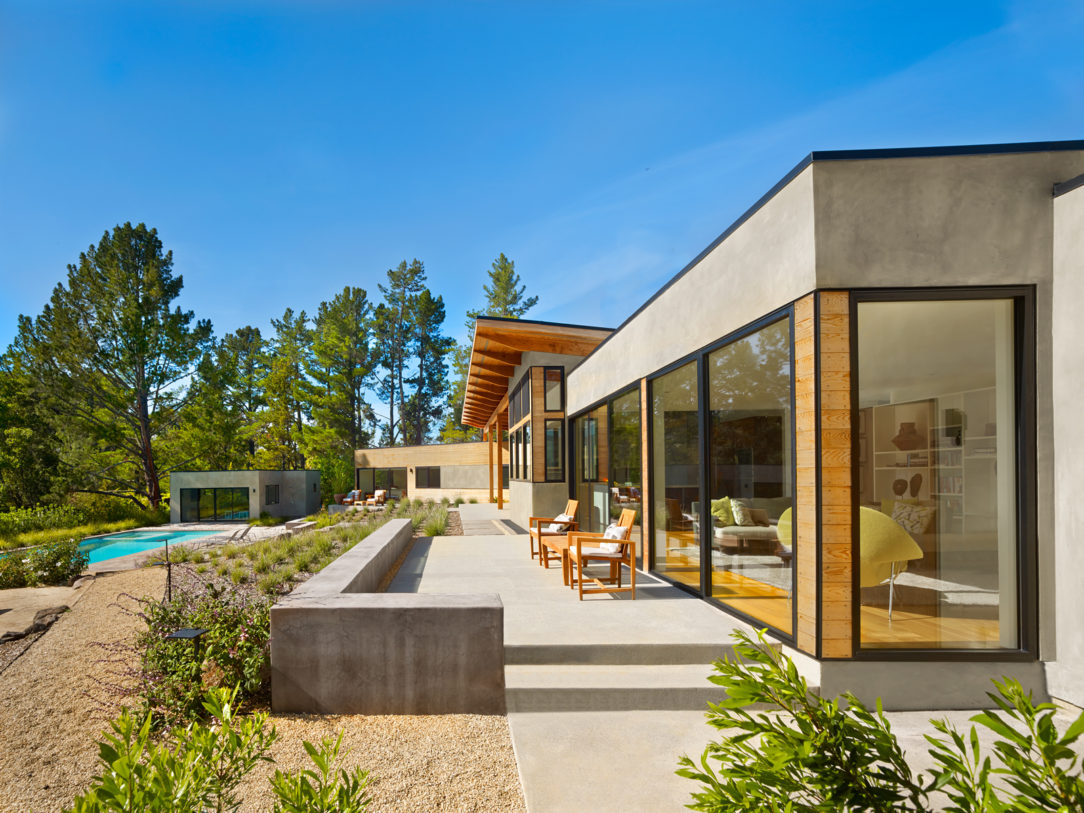Originally published in Silicon Valley Magazine September 2018
Optimism defines the spirit of Silicon Valley architecture as much as it does the tech culture that inspires it, notes architect William Duff, who has designed homes throughout the Bay Area and beyond. “There’s a real optimism here about what can be done in the world,” he says. His latest residential project reflects the anything-is-possible approach that has become a trademark of his San Francisco-based firm. Set atop a hill in Portola Valley, the home for a family of five was designed with two complementary wings to satisfy the yin and yang of the clients’ needs. The homeowners wanted a space that suited their social lifestyle but also provided a quiet retreat from the bustle of work, school and activities in between.
“The big architectural move was to have the butterfly roof,” says Duff. Resembling a butterfly in flight, the soaring roof allows the main gathering space to take advantage of abundant natural light, open-air breezes and unobstructed views of the valley. A secluded three-bedroom, two-bath wing answers the need for a private space. Guests can view the rectangular structure as they walk down the hallway through the main living space, thanks to a mostly glass facade that offers a preview of what’s to come. The dynamism of that intersection between the public and private space, notes Duff, played a central theme in the design. “It feels like you’re making a transition, but as you make that transition, you’re aware of the outside environment,” he says. “You’re aware that you’re going from something that’s much more open to something that’s much more cozy and cocooned.”
Echoing the butterfly roof is a statement canopy at the home’s entrance. “You need more than just a box with a door to create a sense of home—a sense of arrival,” says Duff, adding: “The canopy helps break down the barrier between inside and outside too, so you get a material continuity between the two spaces.” Inside, the open living area feels full of light and space, divided by a Montigo fireplace with porcelain tiles. Above, exposed wood beams extend to the exterior to enhance the architectural gestures that the design embodies. “There’s almost an anthropomorphic quality to it, where the bones of the home are exposed,” Duff continues. “It’s a chance to show this beautiful wood structural element.”
Sustainability was a priority for both the architect and clients, while also keeping budget in mind. A past-its-prime midcentury home existed on the lot, and, in order to rebuild with economy and what Duff refers to as creative efficiency, he and his team decided to reuse its foundation. “The part of the house that has the butterfly roof on top of it, that essentially occupies most of the original foundation,” he says. Connecting the house to its environment was also critical, so Duff and team conducted extensive view and sun studies, observing wind patterns as well to determine the optimal orientation for the home, with the best views looking over the valley toward the coast.
The material palette was carefully considered too. Low-maintenance integral color stucco—according to Duff, “It doesn’t need to be repainted ever”—was used primarily on the main wing, while Western red cedar accents bring in a much-desired expression of warmth (not to mention the practicality of pest- and weather-resistance). The bedroom wing does the reverse, using mostly cedar with stucco accents, creating a harmony in which they each have their own identity, but are still talking to one another, adds Duff.
The pool house plays a supporting role as a minimal, functional space. Duff exercised restraint here by simply re-skinning an existing structure to complement the design, checking off another sustainability point. Perhaps most memorable is the feeling you get when you transition from the public space through the patio and down to the pool. “It’s just a delightful experience, and it enhances the natural beauty of Portola Valley in a way that I think great architecture should,” says Duff. “I think that’s one of the happy surprises—how nicely that turned out, how great that transition feels when you’re in the space.”

